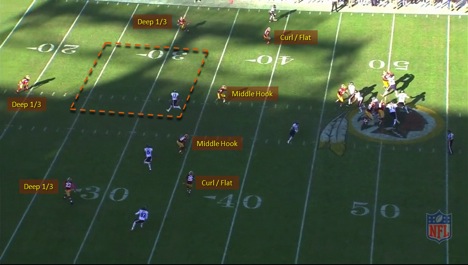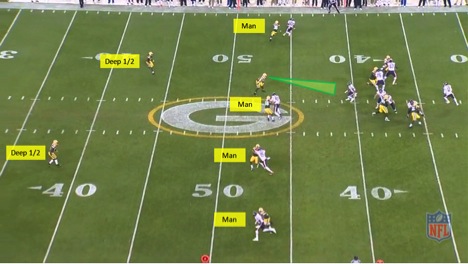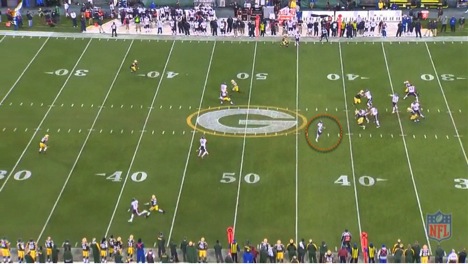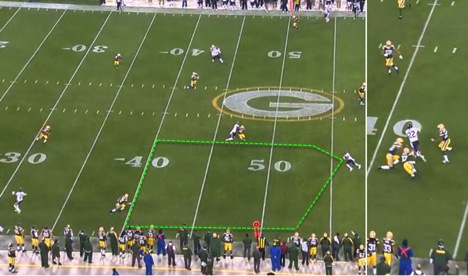Durkin's Playbook: Breaking Down Bears' High/Low Concept
By Dan Durkin-
(CBS) When coaches devise offensive game plans to defeat an opponent, their goal is simple: get their players to an area of the field faster and more frequently than their opponent's defenders.
Bears coach Marc Trestman orchestrates a pass-first offense (59 percent), using a group of base concepts that his team ran with great success last season.
Just last week, we took a look at the Bears' "switched verticals" package, a vertical stretch passing concept with a twist. By switching the receivers' releases off the line of scrimmage, the offense puts the secondary in coverage conflict. Based on how the coverage unfolds, the receivers then perform route adjustments to find open space to operate.
In that column, I highlighted the Bears' rapid improvements in passing yards, total yards and point scored. Another area in which the Bears showed marked improvement was sacks allowed. In 2012, they allowed the eighth most sacks in the league (44). Contrast that with 2013, when they allowed the fourth-least sacks in the league (30).
An infusion of better talent certainly played a part in the drastic turnaround. The Bears made investments along the offensive line in both free agency and the draft. However, coaching and a protect-first mentality – specifically with running backs and in-line tight ends – also played a large role.
With Trestman knowing he has two physically imposing wide receivers who put stress on the top of a defense, as well as a complete running back who is a quality pass receiver and is accountable in blitz pickup responsibilities, another staple of the the offense is "high/low."
High/low is a vertical stretch concept that gives the quarterback a coverage read to isolate on how certain defenders react to having two receivers in their area. The Bears also incorporate a horizontal stretch, using running back Matt Forte on shallow crossing routes, which we will focus on in this column.
Let's go into the film room to take a closer look.
The first example comes from the Bears-Redskins game. The Bears come out in 11 personnel lined up in a 3-by-1 formation out of the shotgun, with Forte aligned to the right of quarterback Josh McCown.
The Redskins respond with their nickel personnel (five defensive backs) in a Cover-3 shell. Pre-snap, strong-side outside linebacker Brian Orakpo is walked out over Alshon Jeffery (the inside slot receiver). Post-snap, the Redskins send Orakpo as a rusher and drop Ryan Kerrigan, ending up in a four-man rush with a Cover-3 zone (three deep, four under).
On the three-receiver side, the Bears stretch the Redskins vertically. Because the middle of the field is closed (single-high safety), Brandon Marshall pushes the vertical seam, while Alshon Jeffery runs a dig. This creates the "high" portion of the read for McCown.
On the single-receiver side, Earl Bennett runs an out route to the sideline to widen both the deep-third and curl/flat defender, leaving a huge void in between the intermediate and deep zones.
Seeing the middle linebacker drop into one of the middle hook zones, Forte knows the Redskins are rushing four and that the Bears thus have enough in their protection count. Consequently, he releases on a shallow crossing route, which stretches the defense horizontally and holds the underneath defenders, creating the "low" portion of the read for McCown.
McCown sees the throwing window and connects with Jeffery on an easy pitch-and-catch first down completion.
McCown quickly diagnosed the three-deep zone coverage during his dropback and read this play high to low. Earl Bennett's quick out and Forte's shallow cross kept the underneath defenders' closer to the line of scrimmage with their drops and stretched the defense horizontally, while the deep routes of Martellus Bennett and Marshall stretched the defense vertically, leaving Jeffery plenty of room to work the dig route.
Here's an example of the same concept and personnel grouping against man coverage from the Bears-Packers game in Green Bay.
The Bears again come out in 11 personnel lined up in a 3-by-1 alignment with Forte to McCown's right. The Packers respond with their nickel personnel in a 2-4-5 alignment. The Bears run a virtually identical route combination.
The Packers drop into two-man coverage with five underneath defenders matching man-for-man and two deep safeties over the top.
Once again, without the inside linebacker rushing, Forte doesn't have protection responsibilities, so he releases on the shallow cross. Inside linebacker A.J. Hawk spies Forte's release, but with Bennett releasing inside, there's some confusion with the Packers' inside linebackers.
Hawk plays a "banjo" technique, meaning he's expecting to exchange responsibilities with fellow inside linebacker Brad Jones, as Bennett tries to "rub" off the defender. Jones however, carries Bennett as well, leaving Forte uncovered underneath.
McCown again reads this play high to low. The Packers have the high receivers covered, so he checks it down to Forte, who has plenty of room to run.
Forte is then splits three defenders en route to a big 33-yard gain.
While the Packers were off in their coverage responsibilities, it's safe to assume the pick from Bennett was by design to get Forte a free release.
The high/low concept is deployed league-wide. The Bears' success comes from each individual player knowing and properly executing their assignments. Players have to buy in to the system and be unselfish, knowing they may be a decoy or a third or fourth option on a play that's designed to give the quarterback easy decisions on how to distribute the football to move the chains and score points.
Follow Dan on Twitter: @djdurkin










